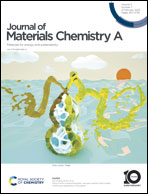Modulation of the morphology and electronic structure of Ni3S2 nano-forests via P and Mo co-doping in polyoxometalates to promote the urea oxidation reaction†
Abstract
Heazlewoodite nickel sulfide (Ni3S2) is a promising catalyst for the urea oxidation reaction (UOR) due to its facile fabrication and low cost. However, the low active sites inhibit the UOR activity of pure Ni3S2. Doping is an effective strategy to modify the active site of an electrocatalyst. Herein, a theory-guided strategy is used for screening the doping elements, and the results indicate that P and Mo co-doping contributes most to enhancing the UOR activity of Ni3S2. Then, P and Mo co-doped Ni3S2 (P–Mo–Ni3S2@NF) is synthesized using polyoxometalate PMo12O40·xH2O as the precursor. Experimental/theoretical results demonstrate that P and Mo co-doping can regulate the morphology and electronic structure, accelerate electron transfer, increase the Ni3+ active sites of Ni3S2, improve the conductivity, and strengthen the urea adsorption and *COO desorption. Consequently, the P–Mo–Ni3S2@NF electrode shows a decent UOR activity and stability, i.e., reaching 1 A cm−2 at a potential of 1.53 V. This work can inspire more insights into doping modification of UOR electrocatalysts.

- This article is part of the themed collection: #MyFirstJMCA


 Please wait while we load your content...
Please wait while we load your content...